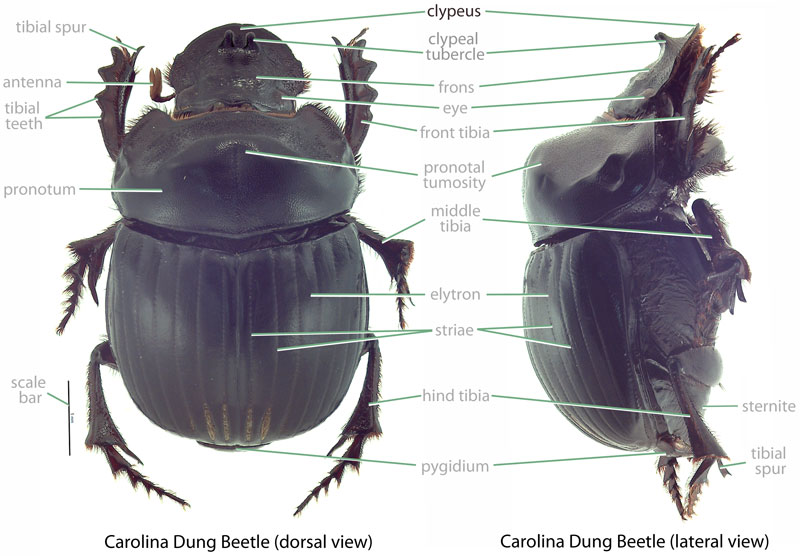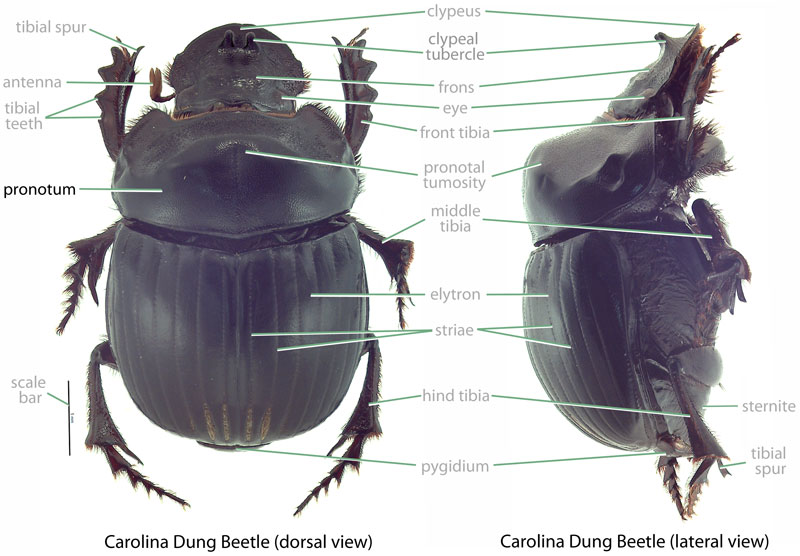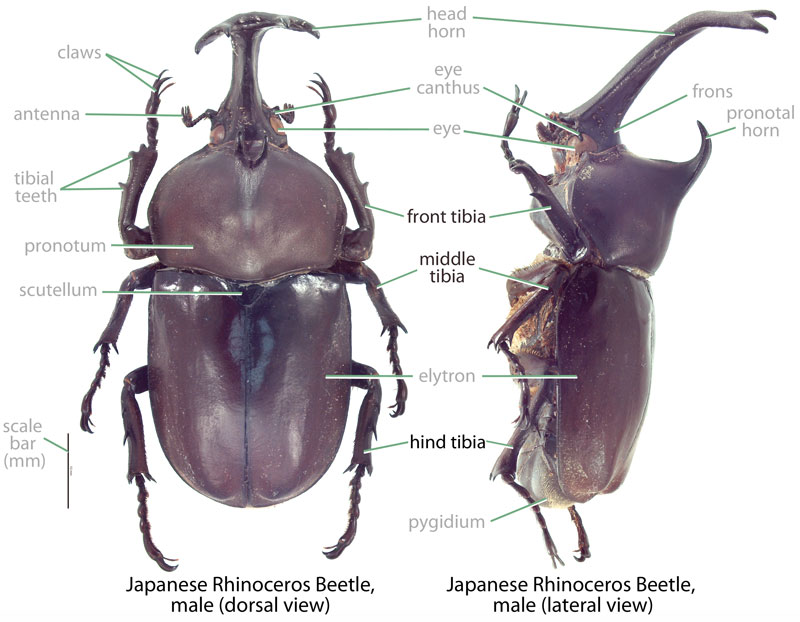Beneficial
tumblebug
Family: Scarabaeidae Subfamily: Scarabaeinae Genus: Canthon Species: Canthon indigaceus Leconte, 1866
none available
Total body length 8.5–12.0 mm (0.33–0.47 in). Body shape round (dorsal view); may be caked in dried dung. Color dark metallic green. Eyes crescent shaped; longer than wide. Clypeusclypeus:
part of the head anterior to the frons; the most anterior portion in dorsal view
 bidentatebidentate:
bidentatebidentate:
a surface that is sharply notched, usually resulting in two tooth-like protrusions on each side of the notch
; surface smooth, never coarsely granulategranulate:
relating to a coarse, grainy surface texture
. Pronotumpronotum:
the dorsal surface of the thorax
 and elytraelytra:
and elytraelytra:
the hardened and chitinous wing-cover of a beetle that protect and overlie the flight wing
smooth, never coarsely granulategranulate:
relating to a coarse, grainy surface texture
. Front tibiatibia:
a segment of the leg articulated with the tarsus and femur
 with apical spurspur:
with apical spurspur:
movable, spine-like process, sometimes mobile, often found at or near the tibial apices
 bifurcatebifurcate:
bifurcatebifurcate:
a process dividing into two points
in male and spine-like in female (spur may be worn down in older individuals). Middle and hind legs elongate. Pygidiumpygidium:
the last abdominal segment, usually exposed, not completely covered by the elytra
 width less than twice height.
width less than twice height.
Undescribed. For Canthon spp. (Ritcher, 1966Ritcher, 1966:
Ritcher P. 1966. White grubs and their allies: a study of North American scarabaeoid larvae. Oregon State University Monographs, Studies in Entomology 4: 1-219.): Grub C-shaped, hump-backed, cylindrical, whitish. Anal slit transversetransverse:
extending horizontally across a surface
. Prothoracic shieldprothoracic shield:
the chitinous plate behind the head of larvae
 with anterioranterior:
with anterioranterior:
the front or forward; opposite of posterior
projecting, angular process on each side. Legs each with a single long, terminal setaseta:
small, hair-like structure
surrounded by numerous short setae; 2-segmented; without stridulatory structures; claws absent.
Southwestern U.S., Mexico, Central America. In the U.S., this species is known only from Arizona and Texas (Robinson, 1948Robinson, 1948:
Robinson M. 1948. A review of the species of Canthon inhabiting the United States (Scarabaeidae: Coleoptera). Transactions of the American Entomological Society 74: 83-100. full text (accessed 2015)). It occurs through much of Mexico, with its distribution extending south to Costa Rica (Solis-Blanco, 2002Solis-Blanco, 2002:
Solis-Blanco A. 2002. The genus Canthon (Coleoptera: Scarabaeidae) in Costa Rica. Giornale Italiano di Entomologia 10: 1-68.).
None. This species is primarily a dung feeder and has not been recorded feeding on live plants. However it has been observed tumbling the rinds of prickly pear (Opuntia spp.) fruit (Novelo et al., 2007Novelo et al., 2007:
Novelo E, Delfín-González H, Moron M. 2007. Copro-necrophagous beetle (Coleoptera: Scarabaeidae) diversity in an agroecosystem in Yucatan, Mexico. Revista de Biología Tropical 55: 83-99. full text (accessed 2015)), suggesting opportunistic feeding on fallen fruit.
None. This species recycles dung and is beneficial for ranching and farming in Hawaii. Primarily being a dung feeder, this species has never been recorded attacking crop or ornamental plants. Additionally, this species is not a threat to native dung beetles because none occur in Hawaii or Guam.
Established. Canthon indigaceus was intentionally introduced to Hawaii. Specimens were released in 1954 at Weima on Kauai, Molokai Ranch on Molokai, and the University of Hawaii Dairy on Oahu (Weber, 1955Weber, 1955:
Weber P. 1955. Recent introductions for biological control in Hawaii—1. Proceedings of the Hawaiian Entomological Society 16: 162-164. full text (accessed 2015)). Similar dung beetle introductions were undertaken to help control populations of the horn fly (Haematobia irritans), a biting pest of livestock (Markin and Yoshioka, 1998Markin and Yoshioka, 1998:
Markin G and Yoshioka E. 1998. Biological control of the horn fly, Haematobia irritans L., in Hawai'i (Diptera: Muscidae). Proceedings of the Hawaiian Entomological Society 33: 43-50. full text (accessed 2015)).
Not established or recorded. There are no records of this species from Guam.
In Hawaii, this species was intentionally released.
This scarab is one of four Canthon species recorded from Hawaii (none are known from Guam). It is distinguished from the other Canthon species recorded in Hawaii by examination of the pronotal texture (texture smooth in C. indigaceus versus coarsely granulategranulate:
relating to a coarse, grainy surface texture
in C. pilularius ), color (metallic dark green in C. indigaceus versus dark blue-black in C. humectus, shining green or red in C. viridis, velvety black to green in C. pilularius), size (C. indigaceus 8.5–12.0 mm [0.33–0.47 in] versus 2.0–4.0 mm [0.08–0.16 in] in C. viridis, 12.0–19.0 mm [0.39–0.59 in] in C. pilularius), and pygidiumpygidium:
the last abdominal segment, usually exposed, not completely covered by the elytra
 shape (pygidium width less than twice the height in C. indigaceus versus width more than twice the height in C. humectus).
shape (pygidium width less than twice the height in C. indigaceus versus width more than twice the height in C. humectus).
Canthon chevrolati Harold, Canthon chiapas Robinson
Report your observation of this beneficial species at our iNaturalist project.